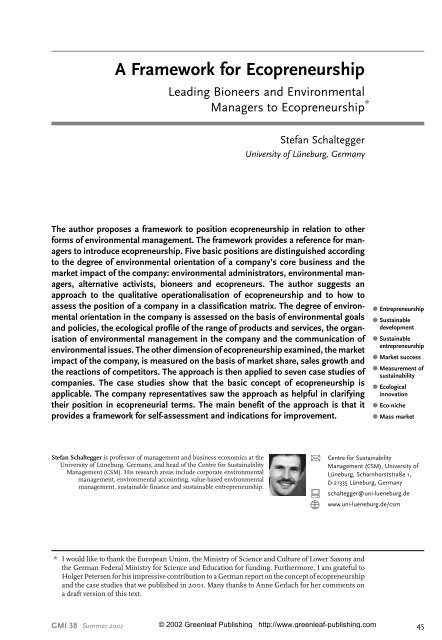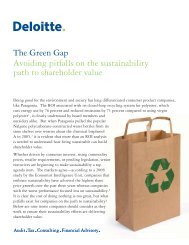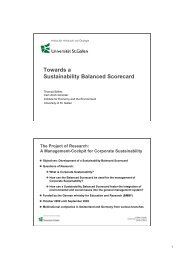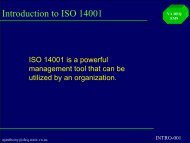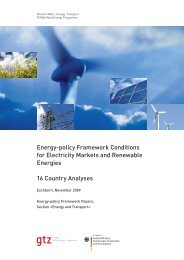A Framework for Ecopreneurship - GreenProf
A Framework for Ecopreneurship - GreenProf
A Framework for Ecopreneurship - GreenProf
Create successful ePaper yourself
Turn your PDF publications into a flip-book with our unique Google optimized e-Paper software.
A <strong>Framework</strong> <strong>for</strong> <strong>Ecopreneurship</strong><br />
Leading Bioneers and Environmental<br />
Managers to <strong>Ecopreneurship</strong><br />
Stefan Schaltegger<br />
University of Lüneburg, Germany<br />
The author proposes a framework to position ecopreneurship in relation to other<br />
<strong>for</strong>ms of environmental management. The framework provides a reference <strong>for</strong> managers<br />
to introduce ecopreneurship. Five basic positions are distinguished according<br />
to the degree of environmental orientation of a company’s core business and the<br />
market impact of the company: environmental administrators, environmental managers,<br />
alternative activists, bioneers and ecopreneurs. The author suggests an<br />
approach to the qualitative operationalisation of ecopreneurship and to how to<br />
assess the position of a company in a classification matrix. The degree of environmental<br />
orientation in the company is assessed on the basis of environmental goals<br />
and policies, the ecological profile of the range of products and services, the organisation<br />
of environmental management in the company and the communication of<br />
environmental issues. The other dimension of ecopreneurship examined, the market<br />
impact of the company, is measured on the basis of market share, sales growth and<br />
the reactions of competitors. The approach is then applied to seven case studies of<br />
companies. The case studies show that the basic concept of ecopreneurship is<br />
applicable. The company representatives saw the approach as helpful in clarifying<br />
their position in ecopreneurial terms. The main benefit of the approach is that it<br />
provides a framework <strong>for</strong> self-assessment and indications <strong>for</strong> improvement.<br />
Stefan Schaltegger is professor of management and business economics at the<br />
University of Lüneburg, Germany, and head of the Centre <strong>for</strong> Sustainability<br />
Management (CSM). His research areas include corporate environmental<br />
management, environmental accounting, value-based environmental<br />
management, sustainable finance and sustainable entrepreneurship.<br />
● Entrepreneurship<br />
● Sustainable<br />
development<br />
● Sustainable<br />
entrepreneurship<br />
● Market success<br />
● Measurement of<br />
sustainability<br />
● Ecological<br />
innovation<br />
● Eco-niche<br />
● Mass market<br />
u Centre <strong>for</strong> Sustainability<br />
Management (CSM), University of<br />
Lüneburg, Scharnhorststraße 1,<br />
D-21335 Lüneburg, Germany<br />
! schaltegger@uni-lueneburg.de<br />
< www.uni-lueneburg.de/csm<br />
* I would like to thank the European Union, the Ministry of Science and Culture of Lower Saxony and<br />
the German Federal Ministry <strong>for</strong> Science and Education <strong>for</strong> funding. Furthermore, I am grateful to<br />
Holger Petersen <strong>for</strong> his impressive contribution to a German report on the concept of ecopreneurship<br />
and the case studies that we published in 2001. Many thanks to Anne Gerlach <strong>for</strong> her comments on<br />
a draft version of this text.<br />
GMI 38 Summer 2002 © 2002 Greenleaf Publishing http://www.greenleaf-publishing.com<br />
45<br />
*
stefan schaltegger<br />
Innovations can alter the economy and society fundamentally. cars,<br />
computers and the Internet have changed the world in a more fundamental way than<br />
have most political programmes. To be innovative means to provide organisational<br />
and technical improvements that can be sold successfully in the marketplace. In order<br />
to create innovations a firm must overcome thresholds.<br />
In a market system, sustainable development requires sustainable innovations and<br />
entrepreneurs who can achieve environmental goals with superior innovations that are<br />
successful in the marketplace. Market innovations that drive sustainable development<br />
do not occur by accident; they have to be created by leaders who put them into the core<br />
of their business activities. Actors and companies making environmental progress in<br />
their core business may be called ‘ecopreneurs’. They generate new products, services,<br />
techniques and organisational modes that substantially reduce environmental impacts<br />
and increase the quality of life.<br />
Joseph Schumpeter (1934) referred to such entrepreneurial activities as ‘creative<br />
destruction’. Ecopreneurs destroy existing conventional production methods, products,<br />
market structures and consumption patterns and replace them with superior environmental<br />
products and services. They create the market dynamics of environmental<br />
progress.<br />
In this paper I aim to provide a typology of ecopreneurship and to distinguish it from<br />
other <strong>for</strong>ms of corporate environmental activities. This typology is summarised by use<br />
of a positioning matrix <strong>for</strong> ecopreneurship that allows management to assess the state<br />
of its company’s environmental and economic activities in relation to other companies.<br />
In the next section I define the term ‘ecopreneurship’ and its derivation from the word<br />
‘entrepreneurship’. I then go on to discuss the elements of the positioning matrix of<br />
ecopreneurship and a first approach to assessing ecopreneurship. This approach is<br />
distinguished from eco-ratings and environmental assessments. In the penultimate<br />
section I present examples of companies and their management that have undertaken<br />
self-assessments of their ecopreneurial position. The company examples represent a<br />
sample of organisations that were regarded as potential ecopreneurial companies and<br />
invited to present their activities by the RIO management <strong>for</strong>um, a Swiss-based nongovernmental<br />
organisation (NGO) promoting eco-efficiency and environmental management<br />
in industry. The case studies illustrate the conceptual approach and show its<br />
usefulness as a self-assessment tool <strong>for</strong> company leaders. Some conclusions are<br />
provided in the final section.<br />
What is ecopreneurship?<br />
The foundation of the notion of entrepreneurship<br />
Economics and management theory neglected the phenomenon of entrepreneurship<br />
<strong>for</strong> a long time. So did the environmental management literature. However, over the<br />
past couple of years more and more authors have started to deal with entrepreneurship,<br />
following from the work of Schumpeter (1934) and Kirzner (1973).<br />
The word ‘entrepreneur’ derives from French and can be taken to mean ‘taking the<br />
initiative to bridge’. An entrepreneur is a catalyst who brings together money, people,<br />
ideas and resources. Whereas all entrepreneurs deal with bridging activities between<br />
suppliers and customers to create and change markets, ecopreneurs differ from conventional<br />
entrepreneurs in that they also build bridges between environmental progress<br />
and market success. Entrepreneurship can describe various phenomena (Lambing and<br />
Kuehl 1997):<br />
46 GMI 38 Summer 2002
a framework <strong>for</strong> ecopreneurship: leading bioneers and environmental managers to ecopreneurship<br />
t Many authors concentrate on the process of a start-up company (Bennett 1991;<br />
Ripsas 1997). In this view entrepreneurs are actors opening a new company and<br />
entrepreneurship is the process of creating and establishing a new company.<br />
t Another aspect of entrepreneurship is that of striving <strong>for</strong> growth (Kyrö 2001;<br />
Timmons 1986). Entrepreneurs are viewed as actors who enlarge companies and<br />
expand businesses.<br />
t Entrepreneurship has also been interpreted as a social movement or some other<br />
kind of environmental grass-root movement (Pastakia 1998). From this perspective,<br />
entrepreneurs are actors who change existing consumption and production<br />
patterns on the basis of individual initiatives.<br />
t Entrepreneurs’ companies are sometimes distinguished from traditional companies<br />
by their capability to innovate and to create competitive advantage (Risker 1998;<br />
Schumpeter 1934; Staber 1997; Wiklund 1999). Entrepreneurship links inventions<br />
with market success.<br />
t Finally, entrepreneurship is characterised by the personal characteristics of a leaderlike<br />
ambition, leadership, team-building personal involvement and commitment<br />
(Keogh and Polonsky 1998; Stevenson and Gumpert 1998).<br />
The term ‘ecopreneurship’ is a combination of two words, ‘ecological’ (‘eco’) and<br />
‘entrepreneurship’. <strong>Ecopreneurship</strong> can thus be roughly defined as ‘entrepreneurship<br />
through an environmental lens’. <strong>Ecopreneurship</strong> is characterised by some fundamental<br />
aspects of entrepreneurial activities that are oriented less towards management systems<br />
or technical procedures and focused more on the personal initiative and skills of the<br />
entrepreneurial person or team to realise market success with environmental innovations.<br />
After a first wave of literature, beginning in the 1990s, only recently have some<br />
authors started to deal in more detail with environmentally oriented entrepreneurship<br />
(see Anderson and Leal 1997; Bennett 1991; Berle 1991; Blue 1990; Isaak 1998; Keogh<br />
and Polonsky 1998; Kyrö 2001; Larson 2000; Lober 1998; Pastakia 1998; Schaltegger<br />
and Petersen 2001; Staber 1997; Wiklund 1999).<br />
Narrow and wide definitions of ecopreneurship<br />
Entrepreneurial thinking starts first with individuals, as environmental preferences are<br />
personal concerns. This is why ecopreneurs such as Claus Hipp (founder of the Hipp<br />
company, one of Europe’s largest producers of baby food), Gottlieb Duttweiler (founder<br />
of Migros, the largest food-supplier in Switzerland) or Ernst Pfenninger (head of Trisa,<br />
a leading European producer of brushes and brooms) embody the combination of strong<br />
environmental and social values with an energetic entrepreneurial attitude. Ecopreneurs<br />
show personal mastery (see Senge 1996) and consider their professional life as<br />
a creative act. Differences between personal goals and the perceived reality are taken as<br />
a challenge and not as a problem (see Senge 1996: 175). Ecopreneurs influence their<br />
company substantially with their personal goals and preferences in a way that these are<br />
reflected in the company’s goals. This is more often and to a larger extent the case with<br />
start-up companies and small companies than with larger enterprises. Whereas<br />
environmental managers can leave a company without the firm losing substantial<br />
character, ecopreneurs constitute and shape the ‘face’ of their company. Because of the<br />
strong influence of the personality of the company leader (or leaders) on company goals,<br />
ecopreneurship and the status of an ecopreneur can also be important to the whole<br />
company. As a consequence, ecopreneurship—defined in a narrow sense—deals with<br />
GMI 38 Summer 2002 47
stefan schaltegger<br />
a start-up of a very innovative company supplying environmental products and services<br />
(<strong>for</strong> a similar definition of entrepreneurship, see Ripsas 1997).<br />
However, ecopreneurs can also be seen in established firms, as the process of creating<br />
substantial market success with environmental products and services also exists in<br />
established companies (e.g. in the process of building up profit centres, spin-offs and<br />
so on). Defined more widely, ecopreneurship can thus be described as an innovative,<br />
market-oriented and personality-driven <strong>for</strong>m of value creation through environmental<br />
innovations and products exceeding the start-up phase of a company. This wide definition<br />
of ecopreneurship takes intrapreneurs (Pinchot 1988), as an important subgroup<br />
of ecopreneurs, into account, as intrapreneurs represent actors inside an organisation<br />
who substantially change and shape the environmental and business growth development<br />
of an existing company.<br />
<strong>Ecopreneurship</strong> is thus distinguished from other <strong>for</strong>ms of corporate environmental<br />
development by the company’s vivid commitment to environmental progress and its<br />
strong desire <strong>for</strong> business growth.<br />
Where do ecopreneurs position their companies?<br />
In this section I will show in more detail what can be understood by ecopreneurship<br />
and how it is distinguished from other types of environmental activity by companies.<br />
After an introduction to the positioning matrix of ecopreneurship, the two main<br />
dimensions of a model (the priority given to environmental goals and market effect) are<br />
discussed in more detail.<br />
Positioning matrix of ecopreneurship<br />
Companies contribute most to the overall environmental progress of an economy and<br />
society if their core business deals with environmental solutions and environmentally<br />
superior products and if their innovations substantially influence the mass market. This<br />
is the main thesis <strong>for</strong> the empirical investigation, outlined in the penultimate section<br />
of this paper and the basis <strong>for</strong> the definition of what is called ecopreneurship.<br />
For a company to have a positive environmental influence it must make a real and<br />
substantial contribution to environmental progress. A real improvement can be created<br />
only if the production processes, products and services are environmentally superior. A<br />
substantial contribution requires that the company exert significant market influence<br />
by gaining a large market share or by influencing competitors and other market actors<br />
(such as suppliers) to adopt superior environmental solutions. Ecopreneurs run companies<br />
that fulfil both requirements (see Fig. 1 ). Ideally, ecopreneurship pulls the whole<br />
market towards more environmental progress. Ecopreneurs strive <strong>for</strong> business success<br />
through environmental solutions <strong>for</strong> the mass market.<br />
To measure how well a company has done, the dimensions of ecopreneurship can be<br />
further subdivided. The priority of environmental goals (the vertical axis in Fig. 1) can<br />
range from low priority (environmental protection is regarded as a trustee duty), to<br />
medium priority (environmental issues are seen as supplemental to conventional business<br />
issues) and high priority (environmental issues are regarded as an integral part of<br />
core business activities). The market effect of the company and its businesses (the<br />
horizontal axis in Fig. 1) can be small (i.e. the alternative scene), medium (i.e. the<br />
successful occupation of an eco-niche) or large (i.e. through a strong influence on the<br />
mass market).<br />
48 GMI 38 Summer 2002
Priority as business goal<br />
a framework <strong>for</strong> ecopreneurship: leading bioneers and environmental managers to ecopreneurship<br />
Environmental<br />
per<strong>for</strong>mance goals<br />
are core to the<br />
business.<br />
Environmental goals<br />
are supplementary<br />
to core business<br />
goals.<br />
Environmental<br />
protection is<br />
regarded as a<br />
trustee duty.<br />
Alternative actors Bioneers Ecopreneurs<br />
Environmental management<br />
Environmental<br />
administration<br />
Alternative scene Eco-niche Mass market<br />
Market effect of business<br />
Figure 1: business continuum: the relationship between the priority given to<br />
environmental issues as business goals and the market effect of the business<br />
Source: Schaltegger and Petersen 2001: 10<br />
The combination of these dimensions provides the business positions shown in<br />
Figure 1 and allows us to distinguish ecopreneurship from other <strong>for</strong>ms of corporate<br />
environmental activities:<br />
t Organisations in which environmental issues are of low priority consider environmental<br />
protection as a trustee duty and concentrate on the implementation of given<br />
environmental regulations and standards. Environmental issues are left to the legal<br />
department and to bureaucracy, which administer the issues according to <strong>for</strong>mally<br />
defined rules and regulations.<br />
t Company leaders who consider environmental issues as being a supplementary<br />
aspect of business establish environmental management systems and departments<br />
that attempt to pilot and control environmental impacts in the most efficient<br />
manner. Cost reduction, the improvement of competitiveness and eco-efficiency,<br />
image campaigns and the differentiation of products and services are major goals<br />
of environmental management.<br />
t Companies located in the upper right-hand side of Figure 1 treat environmental<br />
issues as central to their core business because their economic success is strongly<br />
linked to their environmental per<strong>for</strong>mance.<br />
Along the horizontal axis of Figure 1 the market effect is distinguished by alternative<br />
scenes, eco-niches and mass markets:<br />
t Suppliers characterised by alternative economic modes (e.g. non-monetary swapping)<br />
act among themselves in an alternative scene or eco-scene. Turnover is<br />
intended to secure personal living style. Market goals are non-existent.<br />
t Eco-niches mirror medium-sized market segments and are occupied by bioneers.<br />
The expression ‘bioneer’ is a combination of ‘bio’ and ‘pioneer’ and attempts to<br />
express the central role of research and development and the attempt to find<br />
GMI 38 Summer 2002 49
stefan schaltegger<br />
customers with high preferences <strong>for</strong> their inventions and innovations. Bioneers<br />
focus on attractive market niches with their customer-focused eco-products.<br />
t In comparison, ecopreneurs and their companies aim to gain a large and growing<br />
market share and to achieve high or increasing turnover in mass markets.<br />
Importance of environmental issues <strong>for</strong> the core business<br />
Now the typology has been introduced and a definition has been given, let us look at the<br />
dimensions of ecopreneurship and at a first qualitative approach to measuring ecopreneurship.<br />
The strong environmental focus of the core business is the first major<br />
dimension of ecopreneurship. Three stages or positions are distinguished: administration,<br />
management and entrepreneurship.<br />
Environmental administration<br />
The administrative approach is of a stabilising character and can be interpreted as an<br />
aim to preserve the capital of nature. Environmental administration stresses the<br />
conservation aspect of environmental issues and nature. It reminds management of its<br />
duty to act as a trustee of nature. However, in the corporate context, administration is<br />
focused on correct implementation of guidelines and instructions. This often goes along<br />
with bureaucratic structures and procedures. Environmental administration reflects a<br />
defensive approach. Its aim is to achieve minimal change in market conditions and to<br />
safeguard the status quo. Environmental protection is, then, seen as a duty that has to<br />
be dealt with because of external (legal, market or social) pressures. New social or legal<br />
requirements and technical inventions are seen as menacing developments that<br />
question what has been achieved.<br />
In concrete terms, this approach usually entails the appointment of an environmental<br />
officer to supervise emission standards, regulations and <strong>for</strong>mal company internal procedure<br />
protocols. Documentation is a core activity of environmental administration and<br />
it is an integral part of standards relating to environmental management systems (EMSs)<br />
such as ISO 14001, from the International Organisation <strong>for</strong> Standardisation (ISO) and<br />
the Eco-management and Audit Scheme (EMAS) of the European Union. One of the<br />
main advantages of environmental administration is the safeguarding of legal compliance.<br />
The main disadvantage is the lack of focus on environmental per<strong>for</strong>mance and<br />
the creation of paperwork and environmental manuals that can destroy the motivation<br />
to undertake substantial environmental improvements.<br />
Although environmental administration can be useful to secure legal compliance, it<br />
is in stark contrast to the innovation necessary <strong>for</strong> the achievement of substantial<br />
environmental progress. The improvement of eco-efficiency and eco-efficacy requires<br />
financial investments and commitment.<br />
Environmental management<br />
In comparison to environmental administration, environmental management is<br />
defined as taking a more active approach to tackling problems. To ‘manage’ can be<br />
translated as taking something in hand and gaining control over it. The intention is to<br />
shape the company, its products and services and to take advantage of technical and<br />
social opportunities. This requires that scarce resources such as time, money, energy<br />
and environmental resources are allocated in the most efficient way. Efficiency gains,<br />
not conservation, are the focus of environmental management. A major goal of corporate<br />
environmental management is to increase eco-efficiency, which is expressed as the<br />
ratio of value added to environmental impacts added (Schaltegger and Sturm 1990). To<br />
achieve this, management approaches and tools, such as life-cycle assessment (LCA),<br />
environmental accounting and eco-control (see Schaltegger and Burritt 2000), sustain-<br />
50 GMI 38 Summer 2002
a framework <strong>for</strong> ecopreneurship: leading bioneers and environmental managers to ecopreneurship<br />
ability balanced scorecard (see Figge et al. 2002; Schaltegger and Dyllick 2002) and<br />
environmental management systems (see Tibor and Feldman 1996), have been developed<br />
to control material and energy flows in the most systematic way possible. In<br />
contrast to standards such as ISO 14001, these tools focus on the improvement of<br />
environmental per<strong>for</strong>mance rather than on the correct functioning of a management<br />
system.<br />
To improve the environmental quality in a market system a substantial increase in<br />
eco-efficiency is necessary. However, this will not be sufficient as long as relative<br />
improvements are counteracted by larger amounts of sold and consumed products that<br />
do not themselves contribute to environmental progress. This leads to the entrepreneurial<br />
challenge of substantially contributing to higher environmental quality through<br />
eco-effective products and services.<br />
Environmental quality as an entrepreneurial challenge<br />
To make sure that eco-efficiency gains are not counteracted by higher production,<br />
ecopreneurs must also focus on eco-efficacy. Eco-efficacy describes how well the reduction<br />
of environmental impacts is achieved in absolute terms (see Schaltegger and Burritt<br />
2000). Are the environmental impacts caused by a product throughout the whole<br />
market reduced effectively? This goal cannot be equated to the goal of supplying environmental<br />
or pollution-prevention technologies, as illustrated by the suboptimal effect of<br />
end-of-pipe technologies.<br />
The entrepreneurial challenge is thus to be economically successful with the supply<br />
of products and services that change—on a purely voluntary basis—consumption<br />
patterns and market structures, leading to an absolute reduction of environmental<br />
impact. In contrast to bioneers, ecopreneurs are not usually inventors. Instead of spending<br />
time in laboratories and workshops, ecopreneurs search <strong>for</strong> inventions that they can<br />
shape and place on markets to create turnover (Murphy 2000) and influence market<br />
structures. Only in exceptional cases are successful inventors ecopreneurs at the same<br />
time. However, ecopreneurs often work with bioneers in converting inventions into<br />
market successes. The core activity of ecopreneurs is thus to search <strong>for</strong> business ideas<br />
with products and services that solve environmental problems, to identify the market<br />
potential of inventions and to realise market success with them.<br />
In the extreme, ecopreneurship can thus be defined according to Timmons’s 1994:<br />
48) concept of entrepreneurship:<br />
as a human act that builds something of value from practically nothing. It is the pursuit<br />
of opportunity regardless of the resources, or lack of resources, at hand. It requires a<br />
vision and a passion and commitment to lead others in the pursuit of that vision. It also<br />
requires a willingness to take calculated risks.<br />
The second dimension of ecopreneurship in the positioning matrix is the market<br />
effect, which will be discussed in the next section.<br />
Market effect of environmentally oriented companies<br />
Solutions to environmental problems are without much effect if they remain in market<br />
niches or if market introduction fails (Villiger et al. 2000). Many company examples<br />
that have been discussed as leading cases have had little meaningful market impact.<br />
Table 1 shows three positions of market influence that reflect environmentally oriented<br />
companies in practice.<br />
Production in the alternative scene<br />
Autonomy in management without bosses, the renunciation of hierarchies, craftsmanship<br />
instead of industrial production and the integration of leisure time and work<br />
GMI 38 Summer 2002 51
stefan schaltegger<br />
Characteristic<br />
member of<br />
alternative scene<br />
Enterprise type<br />
supplier of<br />
niche market<br />
market leader<br />
Market served Alternative scene Eco-niche Mass market<br />
Supplier Alternative actor Bioneer Ecopreneur<br />
Customer group Peers A group making<br />
particular demands or<br />
with particular<br />
interests<br />
Strategic focus Identification with<br />
exchange partners<br />
Table 1 the market effect of an environmentally oriented enterprise<br />
Largest range and<br />
number possible<br />
Niche market Market penetration<br />
and market<br />
development<br />
characterise the goals of the alternative scene, which attempts to create a counterculture<br />
to the conventional economy (see Conti 1984). The attraction of the alternative scene is<br />
to break out of normality and obligations of any kind and to create a small world of selfassuring<br />
structures and procedures (see Schulze 1996: 747). However, the total<br />
environmental effect is not of interest, as any imitation on a large scale would contradict<br />
the intentions and motivations of the actors creating the alternative scene. Nevertheless,<br />
the environmental movement of the 1970s and 1980s has created alternative structures<br />
that in some cases have survived <strong>for</strong> three decades and that have provided the background<br />
<strong>for</strong> many entrepreneurs and bioneers who have entered market niches in the<br />
past couple of years.<br />
A focus on eco-niches<br />
Niche market suppliers are companies that specialise in specific customer preferences<br />
(Kotler 1998; Porter 1999). The competition strategy is to focus on one precisely defined<br />
area of the market that is big enough to be economically successful and small enough<br />
to be neglected by the mass-market suppliers. Such suppliers serve exclusive target<br />
groups, with a consequent differentiation strategy. This requires innovation of the<br />
products and services supplied as well as innovation regarding production technologies<br />
and organisational concepts. Large competitors neglect these niches because they do<br />
not recognise them, they do not consider them to be attractive enough or they are not<br />
able to fulfil the specific customer preferences well enough.<br />
Since the 1980s many autonomous producers and green activists have left the<br />
alternative scene and have started to enter commercial market niches (Horx 1985). Some<br />
suppliers (e.g. some producers of organic wines) show similarities to suppliers in the<br />
alternative scene. However, among eco-niche suppliers, property rights are more clearly<br />
defined. The company is characterised by a leader who makes the investment, takes the<br />
decisions and wants to earn money. The customers of such suppliers show a strong<br />
interest in the products or services and are willing to pay supreme prices <strong>for</strong> those<br />
products and services.<br />
Suppliers driven by environmental invention may be called ‘bioneers’—they play the<br />
role of a pioneer by opening new paths of environmental development in markets. This<br />
is why the usual marketing and communication approaches of the mass market are not<br />
considered by bioneers. Apart from having higher income and specific environmental<br />
52 GMI 38 Summer 2002
a framework <strong>for</strong> ecopreneurship: leading bioneers and environmental managers to ecopreneurship<br />
preferences, the customers usually need substantial market and product knowledge and<br />
more time to find the products they are looking <strong>for</strong>.<br />
Many examples of bioneers can be found in the environmental high-technology sector<br />
(e.g. the solar and wind energy sectors), in energy contracting and in the textile industry.<br />
Another group of bioneers are traditional small and medium-sized enterprises (SMEs)<br />
that develop their products and services according to environmental criteria. They are<br />
often led and strongly shaped by a company owner or family authority striving <strong>for</strong><br />
harmony between environmental, social and financial goals.<br />
Although bioneers serve an important function in the environmental development<br />
of products, their direct impact remains small. The majority of customers and the main<br />
flow of materials and energy in the mass markets are not affected by the activities of<br />
bioneers. However, with their innovations, bioneers can influence competition in the<br />
mass market. Whereas in the past many environmentalists have supported the view that<br />
‘small is beautiful’, the environmental management literature has recently started to<br />
step out of niche-market terms and to ‘think big’ in order to gain a substantial<br />
environmental impact in mass markets (Schaltegger and Petersen 2001; Villiger et al.<br />
2000).<br />
Measurement approach and case studies<br />
Given the general description and distinction of ecopreneurship outlined above (pages<br />
47-48), the question arises: how can ecopreneurship be measured in practice? This<br />
question required an approach distinctly different from the usual environmental rating<br />
or environmental assessment approaches, as the attempt is not primarily to measure<br />
the specific status of corporate environmental impact or to check the existence of<br />
environmental management systems. Instead, it is to investigate how well the process<br />
of ecopreneurship is realised.<br />
Towards a measurement approach<br />
To measure ecopreneurship and to test the positioning matrix, the two dimensions<br />
(environmental priorities and market effect) have been operationalised in the following<br />
way (Schaltegger and Petersen 2001: 26ff.):<br />
t Programmes of activities. Business policies, environmental statements, corporate<br />
strategy papers and activity programmes reflect the strategy and the importance<br />
given to environmental issues in the core business. They provide the objectives of<br />
operative management. Concrete assessment questions to measure this aspect of<br />
ecopreneurship are as follows:<br />
– Are environmental principles part of the business policy?<br />
– Are these principles reflected in the strategy papers?<br />
–Have quantitative goals and timetables been defined on the basis of these<br />
principles and strategies?<br />
t Range of products and services. The range of products reflects how well the<br />
company has been able to convert its policies into concrete market actions. The<br />
main question to check this requirement of ecopreneurship is: how environmentally<br />
oriented are the products and services of the company compared with those of<br />
its competitors? A problem with this issue is that a reliable measurement of the<br />
environmental impacts of a product through an LCA is generally not feasible. The<br />
GMI 38 Summer 2002 53
stefan schaltegger<br />
following indicators can be used to approximate this aspect:<br />
– An easy measure is the number of explicitly labelled environmentally oriented<br />
products compared with the total range of products of the company.<br />
– Another proxy is to measure how well the goals defined by the company have<br />
been achieved. This indicator requires that the goals be defined precisely enough<br />
to be measured and that they be made public.<br />
– The product range and production processes can be compared with those of the<br />
main competitors. An environmental benchmarking fails in most cases because<br />
of a lack of data. However, the question of whether there is a substantial difference<br />
in the case of the majority of production processes and products can often<br />
be answered more easily.<br />
– One proxy is to check the opinion expressed by environmental experts, assessment<br />
companies and media. This includes whether environmental criteria of<br />
external assessment organisations have been met and whether eco-labels and<br />
prizes have been received.<br />
– In addition, a comparison over time is necessary to get a picture of whether<br />
ecopreneurial progress exists.<br />
t Organisation and communication processes. <strong>Ecopreneurship</strong> is possible only if<br />
environmental issues are dealt with at a top-management level and integrated into<br />
all business activities. Possible assessment questions are:<br />
– Are environmental issues an integrated part of every management level and<br />
business unit in the company or are environmental matters delegated to an<br />
environmental, legal or public relations department with a bureaucratic organisation<br />
structure?<br />
– Is the company involved in scientific environmental research and development<br />
projects and do these projects address core business activities?<br />
– Are environmental issues and their relation to economic per<strong>for</strong>mance addressed<br />
in the company’s core communication activities (e.g. financial report, advertisements)?<br />
In many cases ecopreneurs tend to give a high priority to oral communication<br />
by the company leader.<br />
t Market effect. A main market effect is directly measurable as market share or sales<br />
of the company. Indirect market effects occur when environmental innovations are<br />
copied by competitors or when an environmental product feature becomes a<br />
standard in the market. Ecopreneurial companies have a large market share and/or<br />
a strong influence on product standards and firm behaviour. In general, the main<br />
requirement <strong>for</strong> achieving this is that the price of the environmental products can<br />
be reduced to the existing market level. Sometimes, they can also extend or develop<br />
a market by influencing a change in legal and political conditions, as in the market<br />
<strong>for</strong> wind energy in northern Europe. Among the main questions leading the<br />
assessment of the market effect as part of ecopreneurship are:<br />
– Does the company have a substantial market share?<br />
– Is the growth of market share and sales larger than the average market growth?<br />
–Have the innovations of the company been copied by competitors?<br />
– Is the price level of the company’s products in the medium range of the market<br />
or does it reflect a niche strategy focusing on an exclusive group of customers?<br />
–Has the company been able to extend the market <strong>for</strong> environmental products?<br />
This is in some cases achieved by political means (see Kotler 1986).<br />
These ways of qualitatively measuring ecopreneurship have been tested through seven<br />
case studies, described below.<br />
54 GMI 38 Summer 2002
a framework <strong>for</strong> ecopreneurship: leading bioneers and environmental managers to ecopreneurship<br />
Case studies on the assessment of ecopreneurship<br />
The following case studies centre on companies that were invited by the RIO Management<br />
Forum in Lucerne to its annual conference. This conference is one of the larger<br />
annual practice-oriented conferences on environmental management and policy in<br />
Europe. The empirical investigation is based on responses to a questionnaire (Schaltegger<br />
and Petersen 2001). The questionnaire was answered by company representatives<br />
and supplemented by in<strong>for</strong>mational material—such as company policy data,<br />
environmental statements and reports, advertisements and communication materials—requested<br />
from the companies during the preparation phase. Table 2 provides an<br />
overview of the seven case studies, which are mainly European companies. Some of the<br />
Company Industry or<br />
market<br />
Ballard Power<br />
Systems<br />
N.A. = not available<br />
Fuel cells and<br />
energy<br />
Geberit Ltd Water closets<br />
and sanitation<br />
Hess Natur Clothing and<br />
natural textiles<br />
Landis &<br />
Staefa<br />
(Siemens<br />
Building<br />
Technologies)<br />
Energy<br />
contracting<br />
Market position Number of<br />
employees<br />
It is a market leader;<br />
however, it is a<br />
bioneer because it is<br />
invention-focused and<br />
the technology has<br />
not yet entered the<br />
mass market.<br />
It is a market and<br />
technological leader.<br />
It is the largest<br />
national mail-order<br />
business <strong>for</strong> natural<br />
clothes.<br />
It is a market leader<br />
and innovation leader.<br />
Migros Food retailer It is the national<br />
market leader.<br />
Rohner Textiles Upholstery<br />
materials and<br />
furniture<br />
textiles<br />
Sika Finanz Ltd Chemicals,<br />
building<br />
materials and<br />
engineering<br />
It is the market leader<br />
in environmentally<br />
friendly textiles <strong>for</strong><br />
furniture.<br />
It is among the<br />
market leaders.<br />
Approximate<br />
sales,<br />
2000<br />
(3 millions)<br />
Table 2 case-study companies involved in the investigation of measurement of<br />
ecopreneurship<br />
Geographic<br />
focus<br />
N.A. 770 World<br />
4,240 1,000 World<br />
200 50 Germany<br />
and Switzerland<br />
15,000 2,000 Europe<br />
81,000 13,000 Switzerland<br />
30 10 World<br />
7,900 1,500 Switzerland<br />
and<br />
Europe<br />
GMI 38 Summer 2002 55
stefan schaltegger<br />
Priority as business goal<br />
companies are internationally oriented and others are focused more on a national<br />
market. For many companies, the entrepreneurial leader is familiar to the public (e.g.<br />
G. Ballard, at Ballard Power; G. Duttweiler, at Migros; H. Hess at Hess Natur). All<br />
companies have environmental or sustainability reports that are released to the media.<br />
All companies are considered either in the portfolio of sustainability funds or in the<br />
portfolio of sustainability venture funds. In addition to the questionnaire and the<br />
examination of company publications and documents, the companies were asked to<br />
position themselves in the ecopreneurship positioning matrix. To do so, the company<br />
representatives were guided by the questions <strong>for</strong> company self-assessment listed above.<br />
In the next step the respondents were interviewed in order to countercheck the results<br />
of the questionnaire and the examination of company documents with the results of the<br />
self-positioning exercise. In some cases the position was changed by mutual agreement<br />
after a discussion of all considered documents and arguments. This was mainly the case<br />
when a difference existed in the company goals and the current position of the company.<br />
The results of the case studies are shown in Figure 2. The squares show the current<br />
positions, the triangles past positions and the circles future positions.<br />
Environmental<br />
per<strong>for</strong>mance goals<br />
are core to the<br />
business.<br />
Environmental goals<br />
are supplementary<br />
to core business<br />
goals.<br />
Environmental<br />
protection is<br />
regarded as a<br />
trustee duty.<br />
Past position<br />
Current position<br />
Alternative actors Bioneers Ecopreneurs<br />
Envisaged future position<br />
Market effect of business<br />
b = Ballard Power<br />
g = Geberit Ltd<br />
h = Hess Natur<br />
l = Landis & Staefa<br />
Environmental management<br />
m = Migros<br />
r = Rohner Textil<br />
s = Sika Finanz Ltd<br />
Environmental<br />
administration<br />
Alternative scene Eco-niche Mass market<br />
Figure 2 adjusted self-assessments of the ecopreneurial positions of the case-study<br />
companies. <strong>for</strong> more details of the companies, see table 2.<br />
The results show to what extent the company representatives identify themselves with<br />
the concept of ecopreneurship. In many cases the role of intrapreneurs was seen to be<br />
as important as the role of the company leader in driving the process of ecopreneurship.<br />
The answers to the assessment questions provided indications of possible steps to<br />
improve the ecopreneurial position. In some cases company internal measures will be<br />
necessary to further develop the position. In other cases (e.g. Ballard Power; ‘B’ in Fig.<br />
56 GMI 38 Summer 2002<br />
b<br />
r<br />
h<br />
r<br />
r<br />
l<br />
h m<br />
g<br />
s<br />
b
2) further technological and external political developments should create the desired<br />
market breakthrough (note the significant movement involved from the current position<br />
to the left of the ‘bioneers’ category to the future envisaged position to the far right of<br />
the ‘ecopreneurs’ category in Fig. 2).<br />
Conclusions<br />
The proposed classification and self-assessment approach is intended to support bioneers<br />
and environmental managers in their attempts to realise ecopreneurship in practice.<br />
Furthermore, the approach provides a framework <strong>for</strong> classification, a terminology<br />
and a first step towards the measurement of ecopreneurship. The case studies have<br />
shown that the basic concept of ecopreneurship and the approach of (self-)assessment<br />
is indeed applicable. The company representatives found the approach helpful in<br />
clarifying their position on ecopreneurial activity and in providing indications as to how<br />
to proceed on their path towards ecopreneurship.<br />
The aim of the assessment approach is not to judge and distinguish ‘good’ from ‘bad’<br />
companies. The main benefit of the assessment of the ecopreneurial position is to<br />
provide a framework <strong>for</strong> self-assessment and to highlight areas <strong>for</strong> improvement. However,<br />
the topic of ecopreneurship has only recently emerged in the literature; there<strong>for</strong>e,<br />
in order to support this process more conceptual work and further development of the<br />
measurement approach is necessary.<br />
References<br />
a framework <strong>for</strong> ecopreneurship: leading bioneers and environmental managers to ecopreneurship<br />
Anderson, T., and D. Leal (1997) Enviro-capitalism: Doing Good while Doing Well (Lanham, MD: Rowman<br />
Littlefield).<br />
Bennett, S.J. (1991) Ecopreneuring: The Complete Guide to Small Business Opportunities from the Environmental<br />
Revolution (New York: John Wiley).<br />
Berle, G. (1991) The Green Entrepreneur: Business Opportunities that can Save the Earth and Make you Money<br />
(Blue Ridge Summit, PA: Liberty Hall Press).<br />
Blue, J. (1990) Ecopreneuring: Managing <strong>for</strong> Results (London: Scott Foresman).<br />
Conti, C. (1984) Abschied vom Bürgertum: Alternative Bewegungen in Deutschland von 1890 bis heute<br />
(Goodbye to the Bourgeoisie: Alternative Movements in Germany from 1860 until Today’) (Reinbeck,<br />
Germany: Rowohlt).<br />
Faltin, G. (1998) ‘Das Netz weiter werfen: Für eine neue Kultur unternehmerischen Handelns’ (‘To<br />
Throw the Net Wider: Towards a New Culture of Entrepreneurial Activity’), in G. Faltin, S. Ripsos<br />
and J. Zimmer (eds.), Entrepreneurship: Wie aus Ideen Unternehmen werden (Munich: Beck): 3-20.<br />
Figge, F., T. Hahn, S. Schaltegger and M. Wagner (2002) ‘The Sustainability Balanced Scorecard’,<br />
Business Strategy and the Environment 11.5: 269-84.<br />
Gartner, W. (1990) ‘What we are Talking about when we are Talking about Entrepreneurship?’, Journal<br />
of Business Venturing 5: 15-28.<br />
Horx, M. (1985) Das Ende der Alternativen (The End of the Alternative Movement) (Munich: Hanser).<br />
Isaak, R. (1998) Green Logic: <strong>Ecopreneurship</strong>, Theory and Ethics (Sheffield, UK: Greenleaf Publishing; West<br />
Hart<strong>for</strong>d, CT: Kumarian Press).<br />
Keogh, P.D., and M.J. Polonsky (1998) ‘Environmental Commitment: A Basis <strong>for</strong> Environmental Entrepreneurship?’,<br />
Journal of Organisational Change Management 11.1: 38-49.<br />
Kirzner, I. (1973) Competition and Entrepreneurship (Chicago: University of Chicago Press).<br />
Kotler, P. (1986) ‘Megamarketing’, Harvard Business Review 2: 32-39.<br />
—— (1998) Marketing Management: Analysis, Planning, Implementation and Control (Englewood Cliffs,<br />
NJ: Prentice Hall).<br />
Kyrö, P. (2001) ‘To Grow or Not to Grow? Entrepreneurship and Sustainable Development’, International<br />
Journal of Sustainable Development and World Ecology 8.1: 15-28.<br />
Lambing, P., and C. Kuehl (1997) Entrepreneurship (Upper Saddle River, NJ: Prentice Hall).<br />
GMI 38 Summer 2002 57
stefan schaltegger<br />
Larson, A.L. (2000) ‘Sustainable Innovation through an Entrepreneurship Lens’, Business Strategy and<br />
the Environment 9: 304-17.<br />
Lober, D.J. (1998) ‘Pollution Prevention and Corporate Entrepreneurship’, Journal of Organisational<br />
Change Management 11.1 26-37.<br />
Murphy, M. (2000) ‘Kohle mit Sonne’ (‘Money from the Sun’), Econy, May 2000, www.econy.de/<br />
magazin/05-00/special2.html.<br />
Pastakia, A. (1998) ‘Grassroots Ecopreneurs: Change Agents <strong>for</strong> a Sustainable Society’, Journal of<br />
Organisational Change Management 11.2: 157-73.<br />
Pinchot, G. (1988) Intrapreneuring (Wiesbaden, Germany: Gabler).<br />
Porter, M. (1999) Competitive Advantage (Frankfurt: Campus).<br />
Ripsas, S. (1997) Entrepreneurship als ökonomischer Prozess (Entrepreneurship as an Economic Process)<br />
(Wiesbaden, Germany: Gabler).<br />
Risker, D.C. (1998) ‘Toward an Innovation Typology of Entrepreneurship’, Journal of Small Business and<br />
Entrepreneurship 15.2: 27-42.<br />
Schaltegger, S., and R. Burritt (2000) Contemporary Environmental Accounting: Issues, Concepts and<br />
Practice (Sheffield, UK: Greenleaf Publishing).<br />
Schaltegger, S., and T. Dyllick (2002) Nachhaltig managen mit der Balanced Scorecard (Management of<br />
Sustainability with the Balanced Scorecard) (Wiesbaden, Germany: Gabler).<br />
Schaltegger, S., and H. Petersen (2001) <strong>Ecopreneurship</strong>: Konzept und Typologie (<strong>Ecopreneurship</strong>: Concept<br />
and Typology) (Lüneburg, Germany: Centre <strong>for</strong> Sustainability Management; Lucerne, Switzerland:<br />
Rio Management Forum).<br />
Schaltegger, S., and A. Sturm (1990) ‘Ökologische Rationalität’ (‘Environmental Rationality’), Die<br />
Unternehmung 4: 273-90.<br />
Schulze, G. (1996) Die Erlebnisgesellschaft (The Experience Society) (Frankfurt: Campus).<br />
Schumpeter, J. (1934) Theorie der wirtschaftlichen Entwicklung (Theory of Economic Development) (Berlin:<br />
Beck, repr. 1993).<br />
Senge, P. (1996) Die Fünfte Disziplin: Kunst und Praxis der lernenden Organisation (The Fifth Discipline:<br />
Art and Practice of the Learning Organisation) (Stuttgart: Klett-Cotta).<br />
Staber, U. (1997) ‘An Ecological Perspective on Entrepreneurship in Industrial Districts’, Entrepreneurship<br />
and Regional Development 24.1: 37-48.<br />
Stevenson, H., and D. Gumpert (1998) Der Kern unternehmerischen Handelns (The Core of Entrepreneurial<br />
Activity), in G. Faltin, S. Ripsos and J. Zimmer (eds.), Entrepreneurship: Wie aus Ideen Unternehmen<br />
werden (Munich: Beck): 93-112.<br />
Tibor, T., and I. Feldman (1996) ISO 14000: A Guide to the New Environmental Management Standards<br />
(Chicago: Irwin Professional).<br />
Timmons, J. (1986) ‘Growing Up Big’, in D. Sexton and R. Smilor (eds.), The Art and Science of<br />
Entrepreneurship (Cambridge, MA: Ballinger).<br />
—— (1994) New Venture Creation: Entrepreneurship <strong>for</strong> the 21st Century (Boston, MA: Irwin).<br />
Villiger, A., R. Wüstenhagen and A. Meyer (2000) Jenseits der Öko-Nische (Beyond the Eco Niche) (Basel:<br />
Birkhäuser).<br />
Wiklund, J. (1999) ‘The Sustainability of the Entrepreneurial Orientation–Per<strong>for</strong>mance Relationship’,<br />
Entrepreneurship: Theory and Practice 24.1: 37-48.<br />
58 GMI 38 Summer 2002<br />
q


